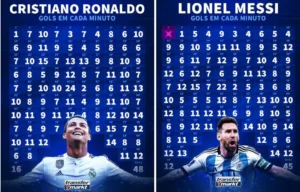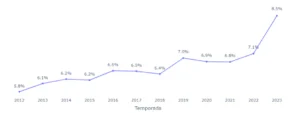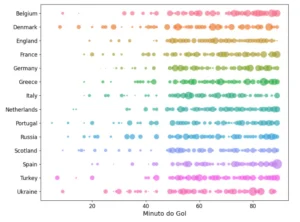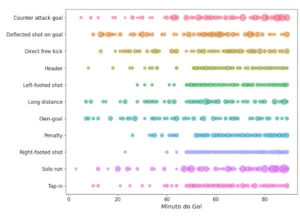In which minutes do most goals happen?

Written by :
Matthew Hanssen

In the first half of the year, the website Transfermarkt, which specializes in the market value of football players, counted all the goals in the careers of Cristiano Ronaldo and Lionel Messi (up until then) separated by the minute in which they were scored.
It was striking that the Portuguese scored, incredibly, in every minute, considering the interval between 1 and 90 – it is important to highlight that in minutes 45 and 90 the stoppage time at the end of each half is also included, therefore having a greater number of goals as it also includes more minutes.
Messi only didn’t score in the first minute of the game, a minute in which is Cristiano Ronaldo’s worst record, with just one goal.

The guy’s decision-making power is evident when we realize that the 44th minute of the second half is his “favorite”, with 16 goals. The Argentine scored 15 goals in the 43rd minute of the first half, his best mark.
But in general, is there a certain minute or period of the game in which more goals are scored? Using Transfermarkt as a data source , we collected more than 180,000 goals between the 2012 and 2023 seasons in 14 different European leagues to try to understand this behavior a little better.
Just like the study done with the two stars, our data also considers the injury time in the 45th and 90th minutes. The first graph below shows the proportion of goals per minute. Each square represents a 60-second interval (with the exception of the two minutes already mentioned) and its size is representative of the whole.

Even disregarding the final minutes of each half, it is already possible to draw a first conclusion: the greatest number of goals occur in the final minutes of the game (for example, at 83, 87, 88 and 89 minutes – together, they represent 5% of occurrences), while goals at the beginning of the game are rare.
Note that the smallest squares are from the initial minutes of each half, such as the first 10 minutes of the first half, in addition to the first two minutes of the second half, between 46 and 47.
To further highlight the importance of the final minutes and concentration throughout the match, below we have the representation of the 90th minute, considering added time, throughout the seasons studied. In 2012, the last minutes of the game accounted for “only” 5.8% of goals. In 2023, this number rose to 8.5%.
It is a fact that there is currently a greater amount of added time due to VAR (Video Assistant Referee), but even before its implementation, the trend was already upwards and it makes it clear that the final minutes have become more and more exciting.

Now, let’s dive a little deeper and analyze the behavior of the European leagues in our database. For this and the next visualization, we removed the 45th and 90th minutes and considered only the most relevant thirty minutes of each competition to avoid visual clutter. Each bubble represents one minute and its size indicates its representativeness in the local league.

Another insight becomes quite clear here: most goals occur in the second half of games , with almost 60% of them being scored in this phase.
The different leagues also showed different patterns in the distribution of goals throughout the minutes. Some leagues, such as England, Portugal and Scotland, showed a more even distribution of goals throughout the minutes, while others, such as France, Greece, Russia and Spain, showed a greater concentration of goals in the final minutes.
Are there also differences depending on the type of finish?
Not much, but we can still see some patterns. The following graph shows how the goals occurred (counterattack, free kick, header, own goal, penalty, etc.) and the representation of the goals in each minute – remembering that only the most relevant thirty minutes are highlighted to make it easier to visualize.

Counterattack goals and individual plays are more concentrated in the final minutes of each half. Perhaps teams are more tired or teams that are losing the game are more vulnerable and throw themselves into attack, making these types of plays easier for the opponent.
Conclusion
As we can see, the final moments of games are crucial for both players and teams. Studying the goals scored by Cristiano Ronaldo and Lionel Messi, as well as analyzing goals scored in different leagues, shows that the final minutes can significantly change the course of a game.
The goals from counterattacks and individual plays, more frequent during this period, reflect the need for a well-developed strategy and good physical and mental preparation to take advantage of these decisive moments.
The increasing trend of late goals, especially since the introduction of VAR, indicates an evolution in modern football, where every second can count for victory. The art of scoring goals transcends pure technique; it is also a test of endurance and, above all, a demonstration of excellence under pressure.
